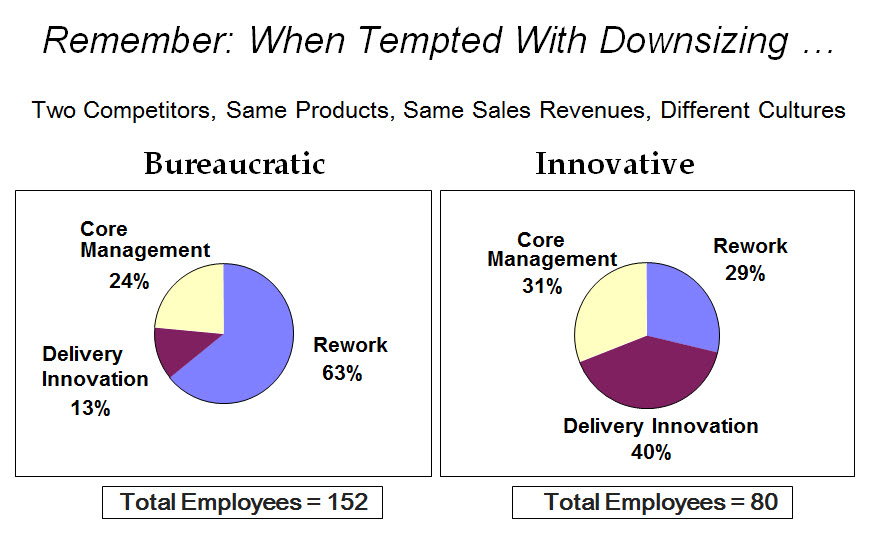
Resisting temptation for the quick overhead fix
Here’s an old lesson that is still highly relevant today.
A company’s culture can have an enormous impact on the bottom line as one business learned. The story occurred a number of years ago. An American automotive parts company was losing business to a Japanese competitor. They were losing so badly that the American company knew it had to cut at least 30% of its staff. But where would they cut? Where would the cuts come from?
Instead of the knee-jerk, ‘scorched-earth’ response (cut across the board) they decided to study the competitor with hopes of discovering how they delivered the same products at a higher quality and at a lower cost.
Bureaucratic Culture vs Innovative Culture – Measurable Results
In a nutshell, what they observed with the Japanese company was an allocation of time and attention to continuous improvement of their business processes. The Japanese company operated with a flatter view of the organization. Everyone, regardless of management level jumped in to look for innovations that would lead to even better results. And this was not a one-time occurrence; it was their way, or their ‘culture’ of innovation that gave continuous improvements.
Their robust, innovative culture valued the continuous, collaborative planning, doing, checking and acting (PDCA for those familiar with Total Quality Management). Contrast this collaborative culture with the Detroit company’s hierarchical, top-down, command and control culture which failed to adapt to the times and increased customer expectations.
Let’s summarize the findings this way for the two competitors who were creating the same products, with the same sales revenues. They had demonstrated two DIFFERENT cultures with these results:
- Bureaucratic culture: Top-down, characterized by paying to put defects in; paying to take defects out. (Staff required: 152 employees.)
- Innovative culture: Collaborative, characterized by managing to not putting the defects in to begin with. (Staff required: 80 employees!)
And because we all know removing defects after delivery is far more expensive than preventing them in the first place, it becomes apparent that the robust, innovative culture, properly managed, will require less labor, lest cost and yield better customer satisfaction.
Instead of randomly cutting staff the American company implemented these lessons and reaped the benefits of lower costs, higher profits, higher reliability.
So the message here is that spending the money differently up front can give a vastly better, more profitable result.
Your company’s culture
Ultimately the company culture can be understood by what people produce, and not simply by what they say or how they feel. Culture involves the implementation or demonstration of values which become obvious by what a company measures, tracks, produces and celebrates.
The right culture will give you a substantial competitive advantage to the benefit of all your stakeholders. As seen in this example, the bottom-line results can be measured.
Taking the next step
If you are wrestling with stretching your budgets, reducing rework, improving customer satisfaction and driving better results to your bottom line, I offer a no-obligation assessment. Having over three decades of experience with thousands of companies of all kinds I know how to get radically better results.
For your assessment please click here to fill out the form or call me 415-246-7264
Looking forward to hearing from you.
Best regards,
Joe Kolinger
P.S. I operate by referral, so if you know of someone who may need assistance I would appreciate the opportunity.
Footnote.
- Mark Blaxill, Fallacy of the Quick Overhead Fix, HBR, 1991
- Joe Kolinger, Seven signs you have a bad project estimate, PMI 2012
- Joe Kolinger, The business case for program management improvement, STC 2007

